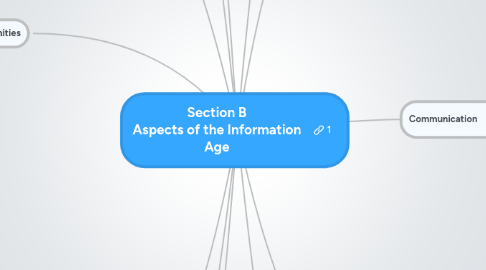
1. Entertainment and leisure
1.1. MP3
1.1.1. Plagiarism issues
1.2. Games
1.2.1. On-line gaming
1.2.1.1. Planetside 2
1.3. DVD players
1.3.1. Portable devices
1.4. Gambling
1.4.1. 'In play' gambling
1.5. Smart Phones
1.5.1. IBM future predictions
1.5.2. Impact on society
1.6. Digital camera's
1.7. Route planners
1.7.1. Garmin
1.8. Smart TV
1.8.1. Recordable TV
1.8.2. Hi resolution / plasma television
1.8.3. Internet enabled TV
1.9. Sports
1.9.1. Statistics
1.9.1.1. Opta stats
1.9.2. Video training
1.9.2.1. Dartfish
1.9.3. Umpire
1.9.3.1. Hawk Eye
1.9.4. Wearable computers (and more)
1.10. Music production
1.10.1. Cubase
1.10.2. top 10 ipad apps
1.10.3. Audio production software
1.10.4. Sound Cloud
1.11. CGI and animation
1.11.1. Software
1.11.1.1. Blender
1.11.2. Augmented reality
1.11.3. training and simulation
1.11.3.1. Military
1.11.3.2. Driving
1.11.4. creative arts
1.11.5. Future of CGI
1.12. Mobile apps
2. Banking
2.1. On-line banking hardware
2.2. Phishing
2.3. ID theft
2.4. Overseas call centres
2.5. BACS online payments (wages, refunds)
2.6. The end of money
2.6.1. Watch 2 Pay
2.6.2. M PESA
3. Employment opportunities
3.1. Job databases
3.1.1. Jobsite
3.2. Candidate databases
3.3. Home-working opporotunities
3.4. Global online working
3.5. Call centres (multinational)
3.6. Government careers service
3.6.1. CV builder
3.7. New sectors of ICT
3.7.1. data architect
3.7.2. mobile app developer
3.7.3. social media marketing
3.7.4. 3D annimation
4. Crime and crime prevention
4.1. CCTV
4.2. Breathaliysers
4.3. Multinational databases
4.3.1. Event protection
4.4. Photo fit technology
4.5. Electronic tagging
4.6. Facial recoignition
4.7. Computer aided dispatch
4.8. Home alarm (linked response)
4.9. Police use Facebook
4.10. Forensic technology
4.10.1. Sound recording
4.10.2. Fingerprinting
4.10.3. DNA
4.10.3.1. News story
4.10.4. Victim Identification
5. Civil rights
5.1. Government use of data
5.2. Equal opportunity data collection
5.3. Exchange of personal data between companies
5.4. Compulsory ID cards
5.4.1. National database?
5.4.2. UK ID card blog
5.5. Privacy international
5.6. Monitoring of internet/email use
5.7. GPS tracking issues
5.7.1. Teen Arrive Alive
5.7.2. Facebook friend tracker
5.7.3. Tracking dementia patients
5.8. CCTV
6. Healthcare
6.1. MRI scans
6.2. Research & data processing
6.3. Ultra sound
6.4. Diabetic monitoring equipment
6.5. GPS tracking dementia patients
6.6. Remote surgery
6.7. Prosthetic technology
6.7.1. open source project
6.7.2. Designing the prosthetics
7. Shopping
7.1. Self checkout
7.2. Product scanners
7.3. Quick response codes (QR Codes)
7.4. Payment methods
7.4.1. Plastic cash methods
7.4.2. Paypal and online
7.4.3. EFTPOS in store payments
7.4.4. Facebook credits
7.5. EPOS computerised tills
7.6. Delivery
7.6.1. Quick next day operations
7.6.2. Overseas delivery methods
8. Working styles
8.1. Net books
8.2. Tablets and PDA's
8.3. Graphics software and tablets
8.3.1. Current trends
8.3.2. Software
8.4. Provision of wi-fi
8.4.1. Sky
8.5. Paperless office
8.6. Collaborative working
8.7. On-line aps
8.7.1. Google translate
8.7.2. Flickr
8.7.3. online bookmarks
8.7.4. New apps
8.8. On-line storage
8.8.1. Google docs
8.8.2. Drop Box
8.9. Online marketing tools
8.9.1. Google adwords
8.9.2. Custmer tracking
9. Communication
9.1. Mobile phones
9.2. Tablets and PDA's
9.3. Answering machines
9.3.1. on-line answering machine
9.4. Fax machines
9.4.1. efax
9.5. 3D / large scale projection
9.6. Automated Call Centers
9.6.1. Lead Desk
9.7. Collaborative apps
10. Education
10.1. Common software
10.1.1. word processing
10.1.2. databases
10.1.3. spreadsheets
10.1.4. free software
10.1.4.1. GNU project
10.2. Student ID cards
10.2.1. Civil rights?
10.3. Multimedia libraries
10.3.1. Reliability and hoaxes
10.4. Interactive smartboards
10.4.1. Products available
10.5. VLE's (virtual learning environment)
10.5.1. online registers
10.5.2. special needs tracking
10.5.3. progress recording
10.5.4. provision of video/image/audio
10.5.5. Moodle
10.6. Availability of materials
10.6.1. Beware of the hoax!
10.6.2. Plagiarism issues
10.6.2.1. Plagiarism detector
10.6.3. You Tube
10.6.4. e-how
10.7. Availability of hardware
10.7.1. Computers
10.7.2. 'Net Books'
10.7.3. Scanners
10.7.4. Tablets
10.7.5. Wireless connectivity
10.7.6. Future of ICT in schools
11. Decision making
11.1. Survey tools
11.1.1. tablet / PDA
